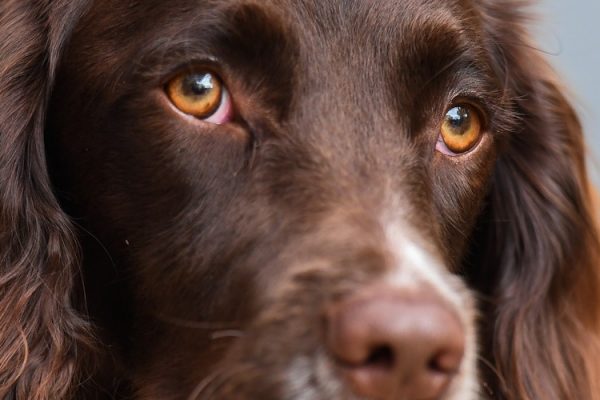Many dog owners often wonder about the way that their pet sees the world around them and whether dogs see things in similar ways to humans.
There is also the question of which is best – dogs or humans?
Dogs and humans experience a similar view of the world around them. Dogs can see what humans see and humans can see what dogs can see. However, there are differences in how the two species see those things and the experiences are not the same.
Can dogs see close up?
Dogs have less fibres than humans do in the optic nerves. This is the area that carries information from the eye to the brain.
What this means is that in certain areas dogs are less effective than humans. The nerves in a human eye connect to a single eye cell, whereas in a dog a nerve connects to several cells.
“This means that the dog has less detail in his vision than a human does.“
If you were able to take your dog to an optician for any eye test then he would give the dog a rating of about 20/75 vision – a good standard in humans is 20/20.
What this means is that the dog can see something in detail that is 20 feet away, but you see the same item, in the same or better detail if it were 75 feet away.

Dogs’ vision is superior when:
It is dark. A dog’s eyes are far better when light levels are low, this is a hereditary quality of a species who hunted at nighttime.
If you have ever shone a torch towards your dog at night and the beam has hit his face then you’ll have noticed the glow that comes from his eyes.
This glow is caused by special cells behind the retina that reflect unabsorbed light enabling a dog to see well when the light levels drop.
Dogs also have a wider field of vision, due, in part to the shape of their skulls, meaning that some breeds can see slightly behind them.
There is also some suggestion that dogs can see some parts of ultraviolet light and also detect magnetic effects on some types of light too.
Do different breeds of dogs see differently?
There are some differences between some breeds of dogs that provide different breeds with different vision qualities.
Short nosed dogs are better at close up vision while long nosed dogs are better at long range sight and have wider fields of view.
Dogs such as pointers and setters with long skulls have good long distance vision which aids them in chasing and catching distant birds and other prey.
How does dog colour vision compare to humans?
Humans have vision that is sensitive to red, blue and green light wavelengths, whereas dogs are tuned into blue and yellow light waves.
Dogs are not colour blind per se and do see colours but they do struggle to deal with red/green mixes which is why, if your dog does not fully work with his nose, he will find it difficult to see and red toy on green grass.
In many ways this is similar to the colour blindness that is experienced in many humans which is often call red/green deficiency.
Dogs struggle to detect differences between red and orange and yellow which is why TV programmes such as Dog TV use colours that are suitable for dogs to watch and enjoy.
Motion and speed of vision
Have you ever played fetch with your dog or seen a dog catch a frisbee?
Dogs are able to process their visual information more quickly than human beings.
This is likely to be another hereditary trait from hunting fast moving game such as rabbits and hares.
“The speed of the dog’s vision means that it sees fast moving things moving at about a quarter of the speed that a human would, so, in effect, it appears slowed down making interception easier.”
The best way to describe it from a human viewpoint is to think about what happens when you are in a dark room with a strobe light flashing.
Items moving in the room appear to be jerky or moving more slowly.
Your dog’s eyesight works in a similar manner allowing your pet to see fast moving objects much more easily and effectively than you can.
The result?
On the subject of dogs vision vs human vision, the two share very similar qualities and are, surprisingly, not that different.
Humans are superior at long distance and close up vision whereas dogs are better when it is dark or when things are moving quickly.
However, when you factor in your dog’s exceptional sense of smell and combine this with his eyesight, it’s fair to say that humans are second best in the sensory department.

